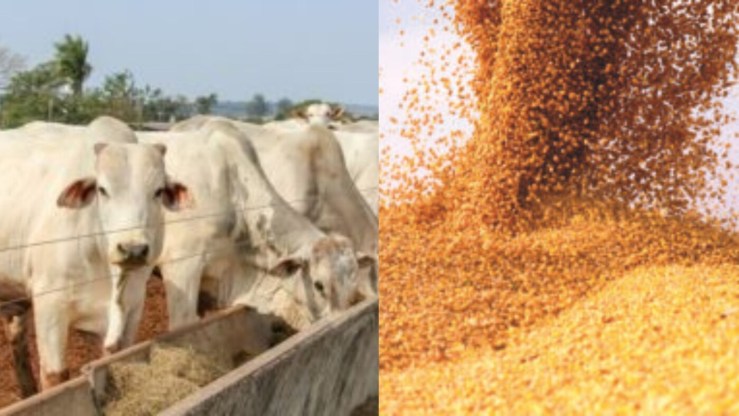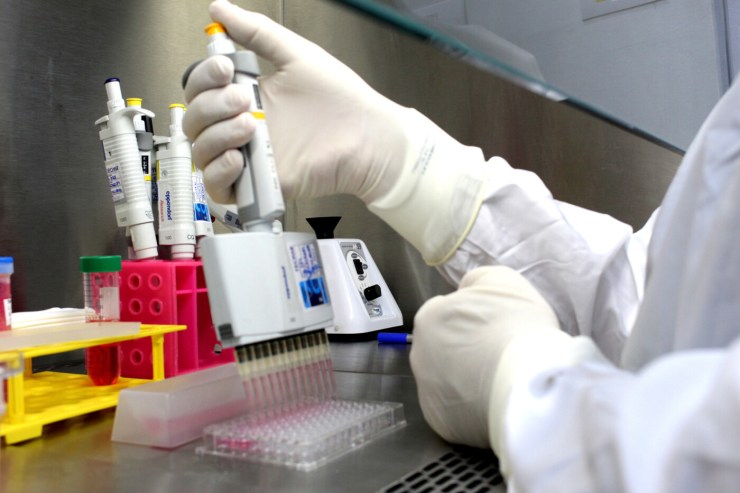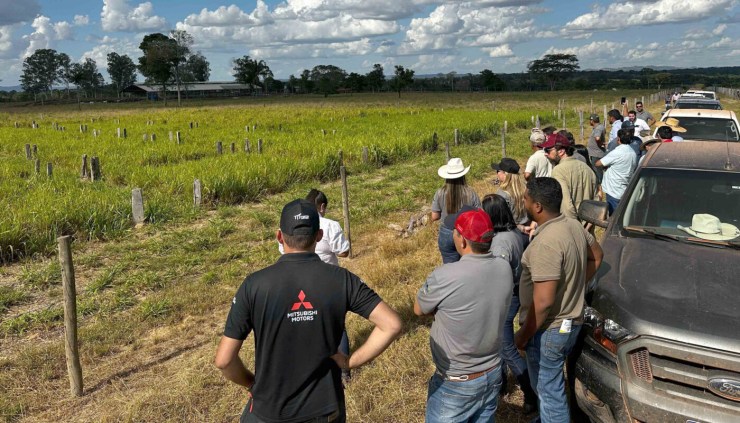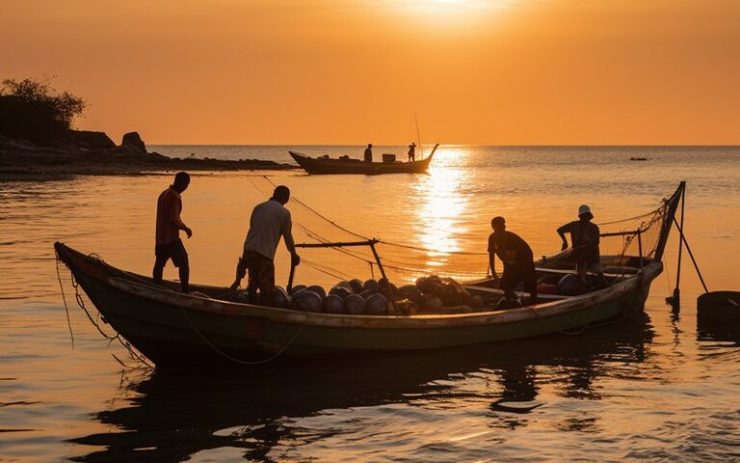A diagnosis carried out by Embrapa Acre on breeding farms in the state revealed that 82% of the producers are family-based and 71% practice calf raising with low adoption of technologies. The lack of adequate infrastructure on these properties is among the main factors that hinder the modernization of production systems.
Among the potential of the activity, the study revealed that 75.4% of the properties have good quality pasture, the result of investment in pasture renovation with the adoption of grasses adapted to the region. The use of these technologies helps to ensure productive and long-lasting pastures, reduces costs with new renovations and avoids the opening of new areas.
Main economic activity in Acre
The main economic activity in Acre, beef cattle farming accounts for 60% of the gross value of the state's agricultural production, and calf raising is the basis for obtaining animals with desirable characteristics for the production of quality meat. Cattle breeding generates work and income for more than 10,000 rural producers in the state, who supply weaned calves to rearing and fattening farms in Acre and other locations in the North, Central-West and Southeast regions of Brazil. To learn about the potential and weaknesses of this activity, researchers from Embrapa visited 246 breeding farms in 12 municipalities in Acre.

Photo: Carlos Mauricio Andrade
The diagnosis paints a picture of the cattle industry in Acre, highlighting positive aspects, the bottlenecks that prevent the adoption of technologies and the demands for public policies in the activity. The results confirm the potential of raising calves in Acre and reveal shortcomings typical of small-scale production. The study coordinator, researcher Carlos Mauricio Andrade, considers that in the challenge of modernizing cattle farming, the first step is to understand the reality of the activity and the profile of producers and properties. This knowledge is essential to identify where the activity is and where it can go.
“We identified technological demands that require technology transfer actions, investments in strategic research for the development of new technological solutions, and public policies to support breeders and develop this economic segment in the state,” he reports. “Since cattle farming is an activity with all links fully integrated, any intervention in breeding cattle generates impacts throughout the chain,” emphasizes the scientist.
There is a lack of information about available technologies
The diagnosis confirmed that cattle breeding is less developed than other links in the livestock chain, although there are available low-cost technologies for the activity. The lack of technology is mainly related to the size of the farm, which defines the economic profile of the property, the level of education of the producers and the lack of information for the breeders about the technologies already made available by the research.
Among the technologies that are not widely used in livestock farming is the intercropping of grasses with legumes. Forage peanuts, the main legume recommended for intercropping, launched by research more than two decades ago, are present in only 6% of livestock farms, despite the plant's great potential to increase pasture productivity.

Photo: Judson Valentim (Xaraés grass intercropped with forage peanuts)
The study also showed that the protocols for controlling the main weeds in pastures, recommended by the research, are not well-known among producers. Another technology that is still little known is direct planting of forage crops, designed mainly for small producers, as it allows for pasture renovation without the use of tractors and with less environmental impact. The technique is already used by large and medium-sized livestock farmers, but is not widely adopted by small producers, which indicates the need for investment in actions to transfer this technology.
Internet is present in 71% of the farms
The study revealed that 711% of producers have access to the internet via smartphones and can resolve most of their demands without having to travel to the city. This communication channel can support actions to disseminate information about the technologies available to modernize the activity.
For Vitor Macedo, a professor at the Acaraú Valley State University (UVA), who also participated in the study, since the internet is a reality even among small producers, it is important to encourage the creation of local knowledge exchange networks. According to him, this would facilitate interaction between more technically-savvy producers, beginners and rural extension technicians, through communication channels, communication apps and social networks.
“Another crucial point is to focus on sharing “input technologies”, which require low investment and have a direct effect on productivity, such as the organization of a reproductive calendar for the breeding season, techniques for identifying and separating herd categories, strategic deworming and pasture management practices”, he highlights.
Pastures with low degradation
Acre currently has the lowest rate of pasture degradation among the states in the North region, in addition to having well-diversified pastures. This finding is very relevant, considering the impacts of Braquiarão Death Syndrome (SMB), a disease that, from the end of the 1990s, caused the degradation of thousands of hectares of pastures in the state.

Photo: Shutterstock
According to the study, only 24.6% of the pastures on the investigated breeding farms require renovation and on 73% of these properties, producers invest in pasture diversification by planting at least three types of grasses. In addition, they use grasses adapted to the climate and soils of the region, recommended by Embrapa.
Brachiaria brizantha, cultivar Xaraés (also known as MG5), launched by the company in 2003, is the most widely planted grass due to its high resistance to soil waterlogging, a typical problem in the Amazon region. “Cattle ranchers in Acre have learned to diversify their pastures and know how to recognize when a pasture needs renovation, using criteria recommended by research to identify symptoms of degradation. The presence of gaps in the pasture, the occurrence of weeds, the increase in the population of native grass and the occurrence of symptoms typical of SMB are the most used criteria, explains Andrade, who also emphasizes that these results confirm that the effort of scientific research to develop and recommend pasture technologies for Acrean livestock has generated positive impacts on the activity”, he evaluates.
More training in the field
The survey also revealed that the average stocking rate used by breeding farms, 2.49 head per hectare, is 27.7% higher than the state average. This indicates that at least one-third of farms have excess cattle, a practice that causes overgrazing and compromises animal performance, pasture persistence and income generation on the property.
Andrade explains that overgrazing is one of the main factors in pasture degradation in Brazil. The problem, which is common on many cattle ranches in Acre, especially small ones, has negative impacts on both the nutrition of the herd and the quality of the pastures. “This scenario highlights the need for more training to increase producers’ knowledge on how to calculate the stocking rate and use this information appropriately in the management of the property’s pastures, a practice that can further reduce the existing levels of degradation,” he emphasizes.

Photo: Licia Rubinstein
According to researcher Judson Valentim, the problem of overcrowded pastures is also a consequence of limited land areas and the perception of producers of cattle as a “savings tool”. “The strategy is to increase the herd and then sell part of it and buy new areas, mainly to improve the scale of production and allow children to stay with their families nearby. On the other hand, there is a lack of technical assistance and access to rural credit, the main drivers for adopting technologies to recover degraded pastures and improve productivity and profitability in livestock farming,” he highlights.
Need for public policies
The results of the diagnosis will guide new research and will support the formulation of public policies focused on modernizing livestock breeding systems to increase production efficiency and sustainability. As this is a family-based activity, the economic profile of the breeders and the size of the property have a decisive influence on investments in the adoption of technologies.
“We have found that medium and large farms have invested heavily in pasture renovation over the past 20 years. However, small farmers with up to 100 head of cattle have difficulty making this investment. One of the technological solutions that can help change this scenario is direct planting of forage crops, a technique that eliminates the need for mechanization of the soil, which makes the pasture renovation process more expensive, and helps preserve the fertility and structure of this natural resource. There is a clear demand for public policies focused on increasing the adoption of this technology in Acre’s livestock farming sector,” emphasizes Andrade.
Another point that, according to the diagnosis, needs improvement is the genetics of the calves produced. Although the genetic standard of the Acre herd is relatively good, Acre needs to invest in genetic improvement, especially to export calves. Due to small-scale production, many producers have difficulty purchasing bulls with a high genetic standard. “Approximately 80% of breeders use “top-of-the-line” bulls as breeding stock, that is, animals of unknown genetic merit. These producers have no guarantee that these animals will produce good offspring, and this compromises the genetic quality of the herd,” explains Andrade.

Photo: Disclosure/ANPC
Among the strategies identified by the study to overcome the limitations on the adoption of technologies for the genetic improvement of cattle herds in breeding cattle is the Progenética program, an initiative of the Brazilian Association of Zebu Breeders (ABCZ), which works in partnership with Banco do Brasil to support breeders by providing financing for the acquisition of improved bulls. This public policy exists in other regions and the government of Acre can encourage its expansion to the state.
For Valentim, solutions to the technological bottlenecks identified in cattle breeding necessarily involve expanding producers’ access to ongoing, quality technical assistance and to rural credit lines from the National Family Farming Program (Pronaf). “In addition, it is crucial to expand the actions of the Organization of Brazilian Cooperatives (OCB), aiming to support the creation of cooperatives and associations as a mechanism for collective purchases of agricultural inputs and for the joint marketing of calves,” he highlights.
Modernization must be gradual
Vitor Macedo argues that the process of consolidating livestock farming as a sustainable commercial activity in Acre requires a set of integrated actions, mainly involving public policies and training. Initiatives such as prioritizing rural technical high school education and offering ongoing training in management, administration and entrepreneurship for young people and children of producers can be effective in this process. “It is also essential to allocate public investment to the maintenance of roads and highways, to reduce logistics costs and connect producers to markets, in addition to facilitating access to credit lines with grace periods and subsidized interest rates aimed mainly at small properties, together with specialized technical management monitoring services,” he emphasizes.
According to Macedo, the modernization of this productive activity needs to be gradual and adapted to the socioeconomic reality of small family producers. “Modernization, in this case, does not mean the immediate adoption of sophisticated technologies, but rather promoting the progressive elevation of the technological standard of breeding farms, with a focus on practical and economic viability for producers.”





